NATIONAL PARK SERVICE
Park Structures and Facilities
|

|
BRIDGES and CULVERTS
BRIDGES IN PARKS include foot, bridle trail, and
vehicle bridges of widely varying widths, spans, heights, and types of
construction. In the interest of limiting the classifications within
this compilation, the less frequent underpass and the minor culvert are
embraced within this section.
In outward appearance, the bridge calls most
importantly for visible assurance of strength and stability. To be
entirely successful, it is not enough for the bridge to be functionally
adequate within the exact knowledge of the engineer; it must proclaim
itself so to the inexact instincts of the layman. In gesture to the lay
concept of structural sufficiency, it is pardonable park practice to
venture well beyond sheer engineering perfection in the scaling of
materials to stresses and strains.
The attainment of "the little more" that is so
desired by those who would have an eye-appeal scale brought to the
slide-rule, is all too rare in park bridges. Rather is there a too
prevalent flimsiness, ocular rather than structural. Considerably fewer
bridges fail to satisfy by seeming too ponderous for their function.
After the attainment of a sufficiency in material
pleasing to the eye, the next demand to be made upon bridges would be
for variety, avoiding the commonplace at one extreme, and the fantastic
at the other. The ranges of use, span and height, and the broad fields
of materials, arch and truss forms, local practices—among other
variety-making possibilities—promise endless combinations and
cross-combinations that could make for such individuality among bridges
that none need ever appear the close counterpart of another.
This presentation seeks merely to focus on the
characteristics that bring to bridges the most promise of compatibility
with natural environment. There is elsewhere abundant information,
including diagrams, rules and formulae, for the design of structurally
enduring bridges. Much more limited is the field of source material that
concerns itself with bridges that, by reason of appropriateness to
natural environment, truly deserve to endure. There are far too many
bridges which, after breaking every commandment for beauty and fitness,
seem to have sought to wash away all sins through the awful virtue of
permanence. Such penitent bridges should have no place in our parks. The
quality of permanence cannot be considered a virtue in itself. Unless
every other desirable virtue, big or little, is present, permanence is
only a vicious attribute.
In general, bridges of stone or timber appear more
indigenous to our natural parks than spans of steel or concrete, just as
the reverse is probably true for bridges in urban locations or in
connection with broad main highways. Probably there are few structures
so discordant in a wilderness environment as bridges of exposed steel
construction.
Too great "slickness" of masonry or timber technique
is certain to depreciate the value of these materials for park bridges.
Rugged and informal simplicity in use is indisputably the specification
for their proper employment in bridges.
In no park structure more than bridges is it of such
importance to steer clear of the common errors in masonry. Shapeless
stones laid up in the manner of mosaic are abhorrent in the extreme. In
bridges particularly is there merit in horizontal coursing, breaking of
vertical joints, variety in size of stones—all the principles
productive of sound construction and pleasing appearance in any use of
masonry. The curve of the arch, the size of the pier, the height of the
masonry above the crown of the arch are all of great importance to the
success of the masonry bridge.
Timber bridges may utilize round or squared members
to agreeable results. Squared timbers gain mightily in park-like
characteristic when hand-hewn. A common fault in bridges is the too
abrupt termination of the parapet, railing, or wing wall. These should
carry well beyond the abutments.
In general disfavor for park use are bridges of the
open wood truss type. There seem to be no arguments to their advantage,
while many are raised against them. In spite of most careful detailing
to prevent water entering and lying in the joints, this is hard to
overcome entirely. Shrinking of the timbers, rack under impact and
strain, and rot developing in the opening joints speed the deterioration
of this type of construction. It is short-lived and soon unsafe.
The culvert is too often handled as a conspicuous
bridge, when in reality it is merely a retaining wall pierced by a
drain. The facing of the culvert, like the treatment of almost every
other facility in natural parks, should be first and always informal and
inconspicuous. Facing and culvert proper should be adequate in materials
and in workmanship so that once constructed both can be forgotten and
make no demands upon maintenance appropriations.
The culvert proper is sometimes of local stone when
this is abundant and workable, but if, as is more frequently the case,
it is of concrete or of galvanized iron, reasonable concealment of the
fact is to be striven for. The retaining wall that is the end wall or
facing of the culvert should avoid disclosing that it is a mere veneer
by extending well into the culvert opening. Natural rock is certainly
the preferred material for the end walls. It may be laid either in
mortar, or dry, but the latter method of laying to be lasting should be
undertaken only when the available stone is of suitably large size.
If stone is not available locally or from within a
reasonable distance, concrete or wood must be resorted to in
constructing the retaining wall. Either is an unsatisfactory substitute
for the stone wall—concrete because of its harsh surface, and lack
of permanence if inexpertly mixed, and wood because of its tendency to
deteriorate rapidly under conditions of moisture.
As much care should be given to the design and
execution of culvert end walls as to other park structures. Usual
mistakes are insufficient care in the handling of mortar, resulting in
sloppy joints, and lack of variety in stone sizes, leading to monotony
and formality of surface pattern. These faults are common to much
contemporary stone work, not limited to park construction only.
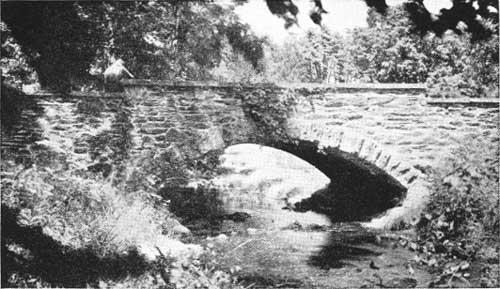
|
BRIDGE, WESTCHESTER COUNTY, NEW YORK
"Top flight" in all details that make
a masonry bridge truly a delight to the eye and assimilable in a haunt
of Nature. If the information regarding this example is accurate, it is
relayed here with some embarrassment. It is said to be an ancient
structure—not a consciously produced bridge of park implications.
Achievement will be considerable when, purposing to create park bridges
of equivalent distinction, actual accomplishment is more the rule and
less the exception.
|
Minor Bridges
Surrounding are bridges of the most elementary
pattern, mere platform bridging an obstacle. The upper three are foot
and horse trail bridges, of a type termed in France a passerelle.
The lower examples are the same basic idea widened to accommodate
vehicles and equipped with low curbs.
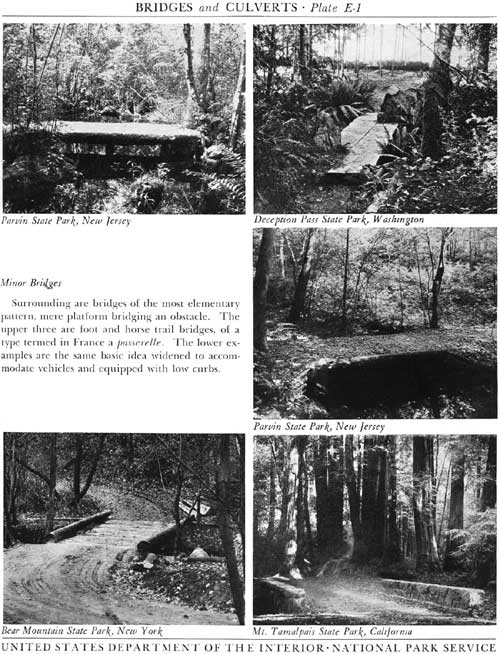
|
|
Plate E-1 (click on image for a PDF version)
|
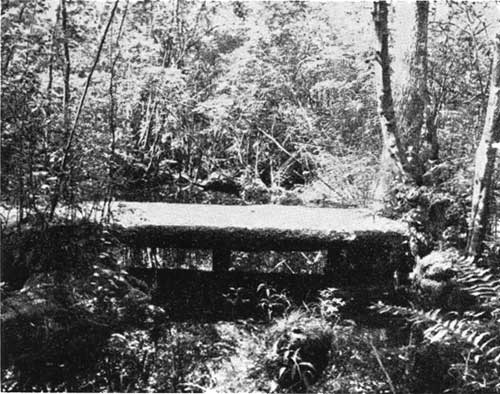
|
|
Parvin State Park, New Jersey
|
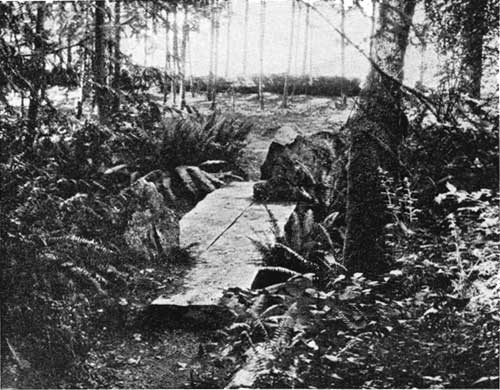
|
|
Deception Pass State Park, Washington
|
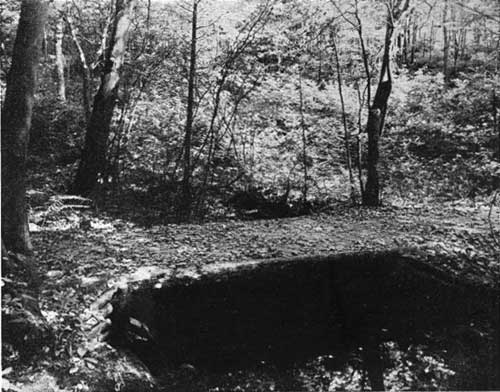
|
|
Parvin State Park, New Jersey
|

|
|
Bear Mountain State Park, New York
|
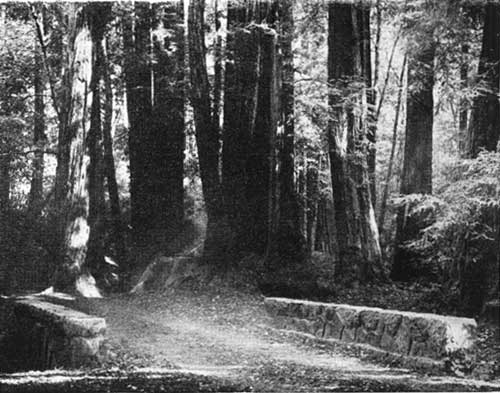
|
|
Mount Tamalpais State Park, California
|
Minor Bridges with Railings
In four of the bridges illustrated on this page the
narrow passerelle has been furnished with hand rail on one side,
low curb on the other. A considerable picturesqueness results, accented
by the vigorous rusticity common to all. The fifth bridge, at lower
left, borrows the graceful and pleasing segmental arch form
characteristic of the oriental bridge, a twice pleasing line if we think
to inventory the aesthetic value of the reflection.
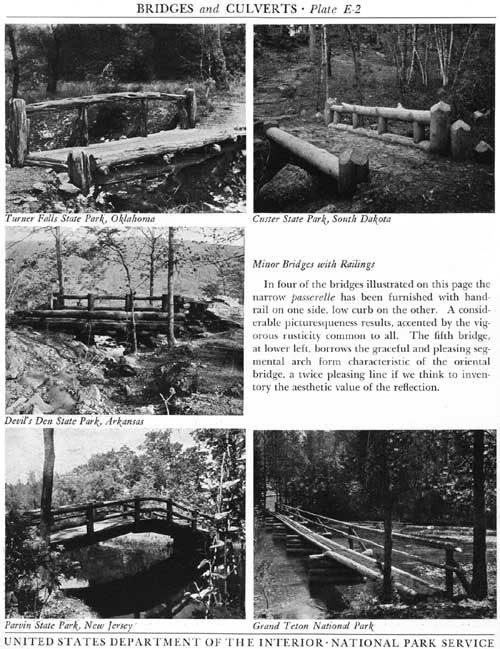
|
|
Plate E-2 (click on image for a PDF version)
|

|
|
Turner Falls State Park, Oklahoma
|
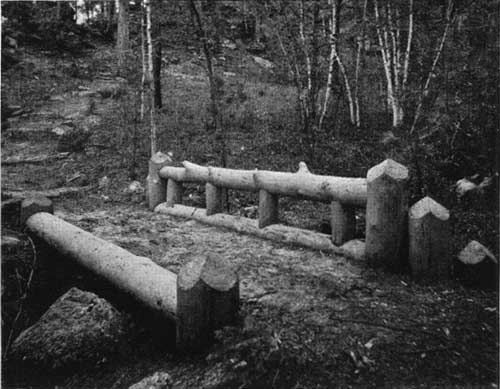
|
|
Custer State Park, South Dakota
|
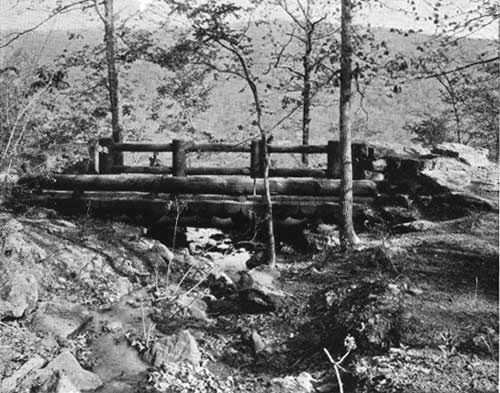
|
|
Devil's Den State Park, Arkansas
|
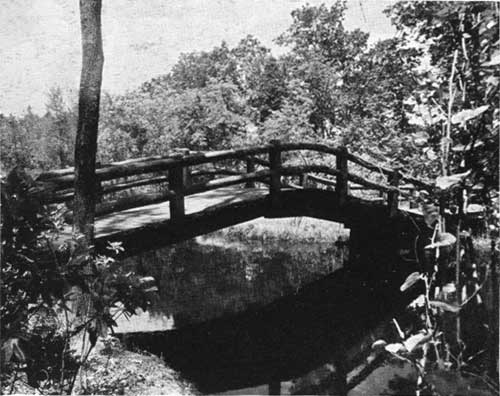
|
|
Parvin State Park, New Jersey
|
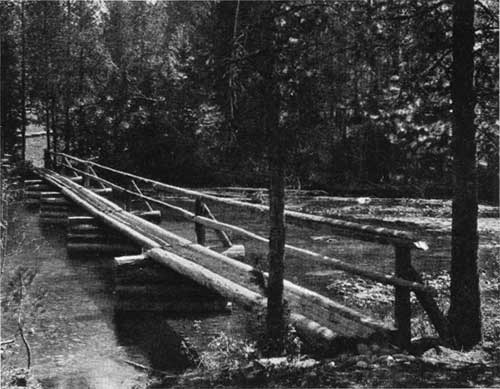
|
|
Grand Teton National Park
|
Minor Vehicle Bridges
Grouped here are five bridges of vehicle width,
constructed of wood girders, decks and railings. Only the railing of the
example directly to the right hints of inadequacy, but the eye is
immediately attracted and diverted by the exposed ends of the puncheons that
form the floor. The two lower examples are particularly vigorous in
scale.
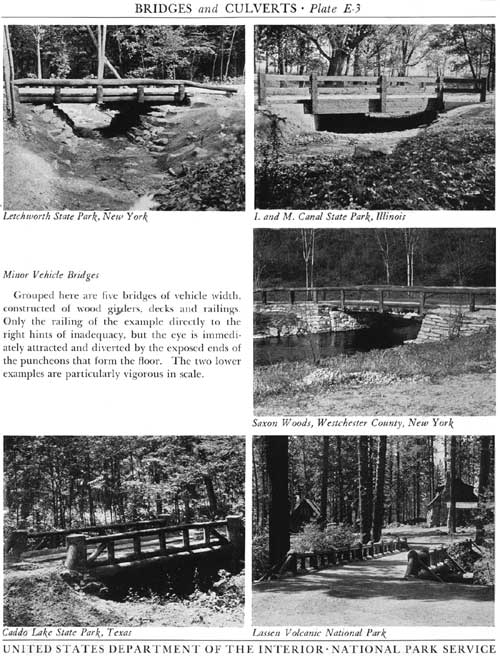
|
|
Plate E-3 (click on image for a PDF version)
|
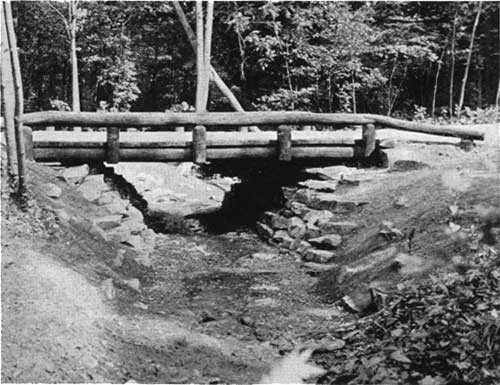
|
|
Letchworth State Park, New York
|
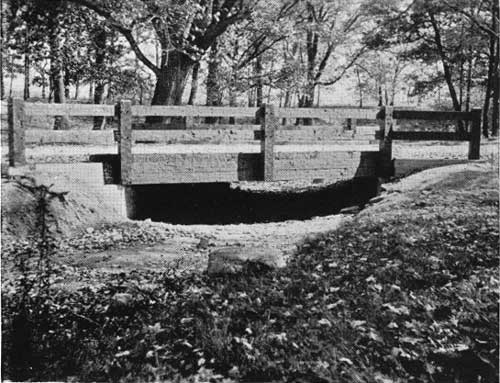
|
|
I. and M. Canal State Park, Illinois
|
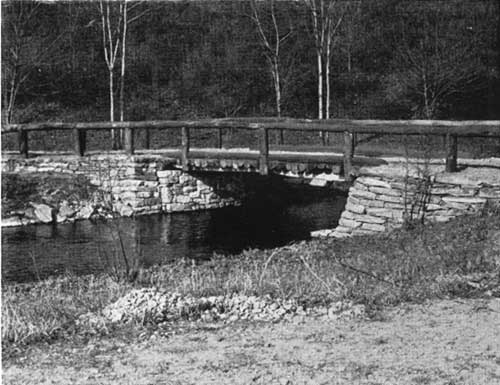
|
|
Saxon Woods, Westchester County, New York
|
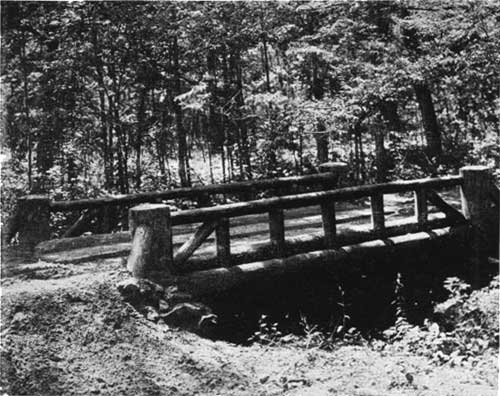
|
|
Caddo Lake State Park, Texas
|
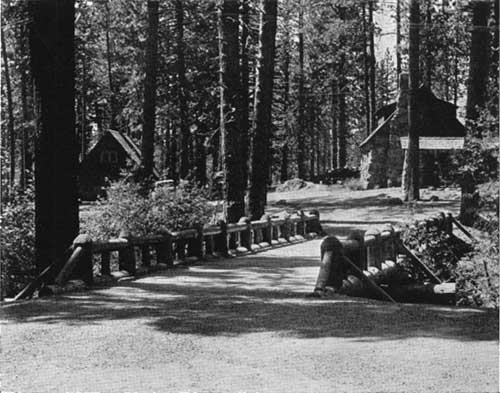
|
|
Lassen National Park
|
Wood Bridges
This grouping lumps together foot bridges and vehicle
bridges, bridges with component members squared and in the round, and
those with support supplied by beams and by truss forms. The two
examples below exemplify the decorative but not thoroughly practical
open truss construction, not generally favored in park usage. The
surfaces of the bridges of squared timbers show a skillfully handhewn
texture.
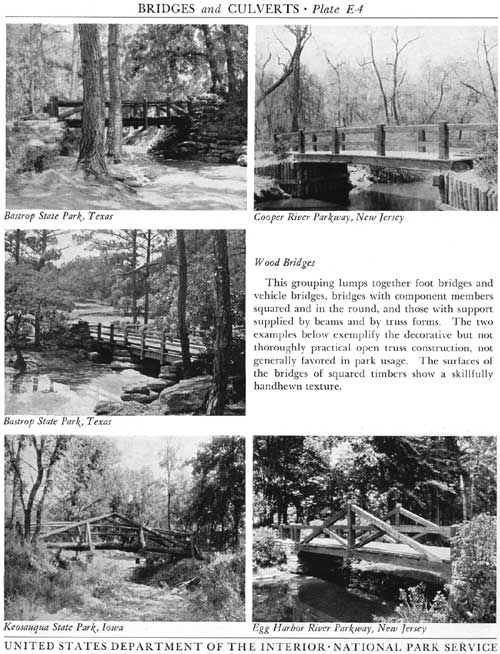
|
|
Plate E-4 (click on image for a PDF version)
|
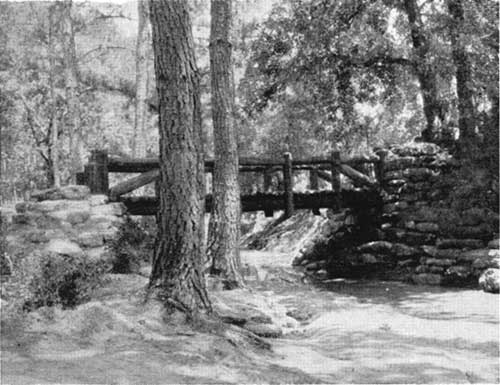
|
|
Bastrop State Park, Texas
|
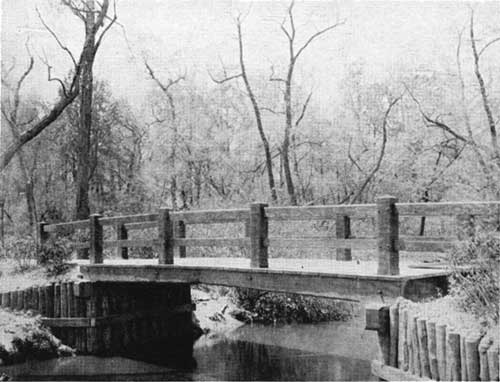
|
|
Cooper River Parkway, New Jersey
|
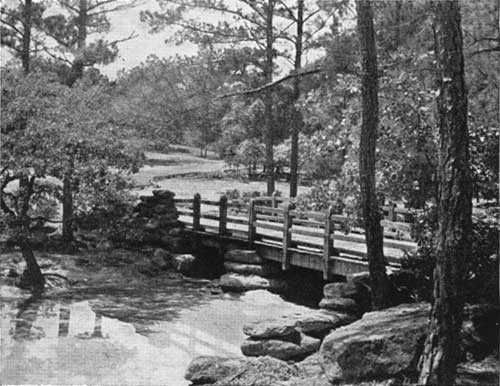
|
|
Bastrop State Park, Texas
|
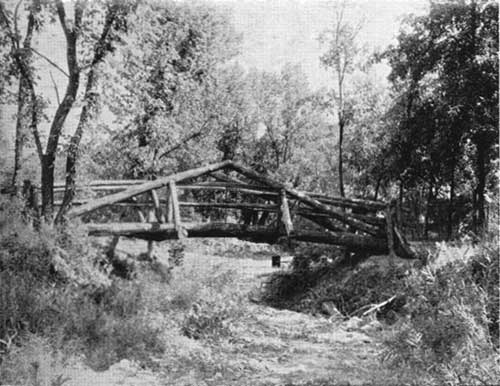
|
|
Keosauqua State Park, Iowa
|
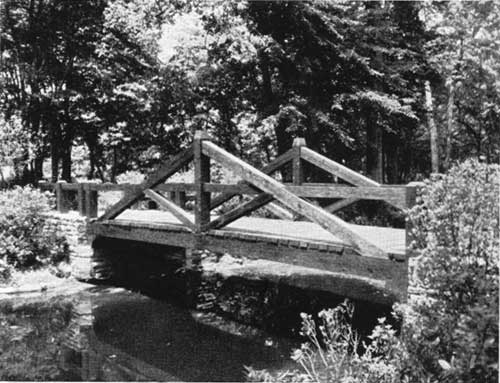
|
|
Egg Harbor River Parkway, New Jersey
|
Bridges of Masonry and Wood
Above are constructions in which the stone abutments
are so prominent that the impression almost of stone bridge is created,
although beams, floor constructions and railings in both cases are of
wood. The upper right example is both underpass and bridge. The other
bridges are masonry structures, except for wood railings. The bridge
shown at lower right is actually of reinforced concrete, but the stone
abutments and piers, and the prominent wood railing, cleverly minimize,
almost deny, any impression of concrete.
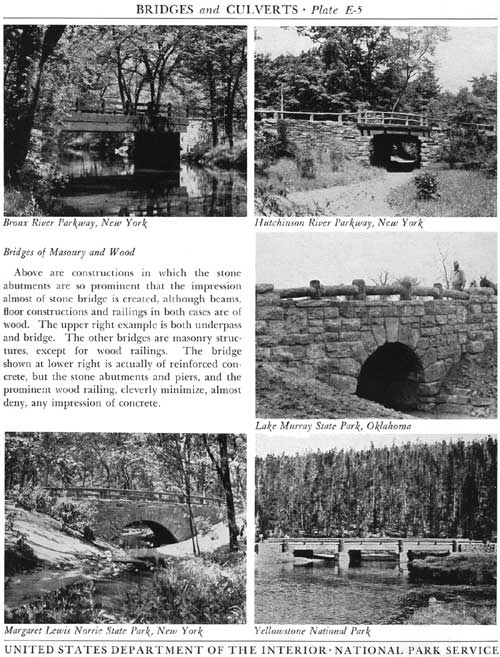
|
|
Plate E-5 (click on image for a PDF version)
|
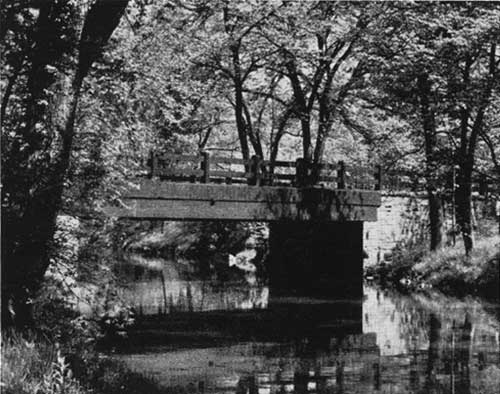
|
|
Bronx River Parkway, New York
|
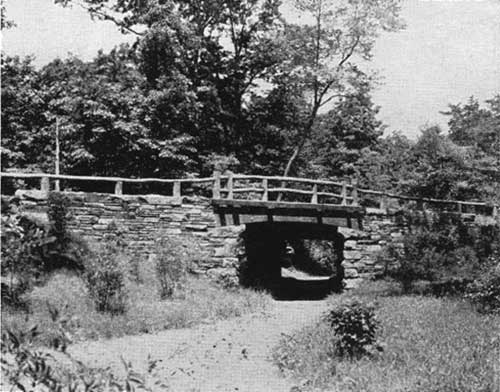
|
|
Hutchinson River Parkway, New York
|
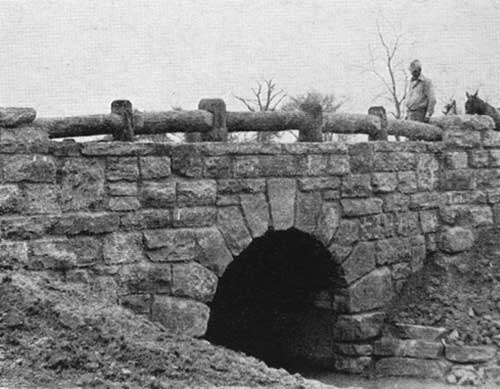
|
|
Lake Murray State Park, Oklahoma
|
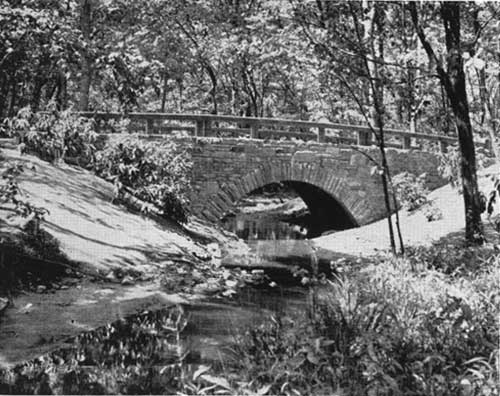
|
|
Margaret Lewis Norrie State Park, New York
|
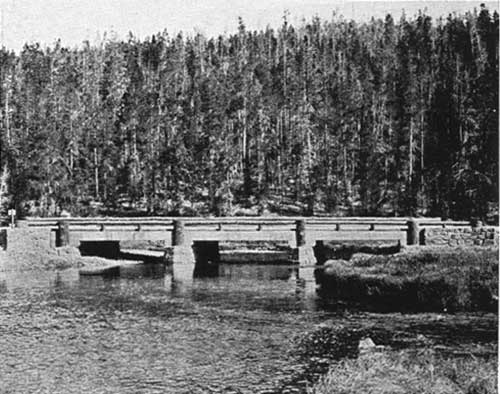
|
|
Yellowstone National Park
|
Stone Arch Bridges
Five stone park bridges that exhibit wide variety of
stone techniques and arch forms. The latter range from semicircular to
the flattened form of the lengthy span at Taughannock Falls State Park.
Noteworthy in the example directly to the left is the fact that the
stone arch is not mere facing of a concrete arch but extends the full
width of the bridge and functions structurally.
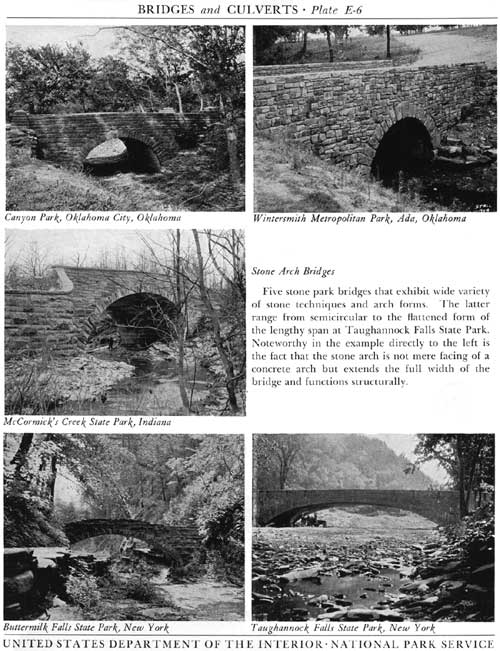
|
|
Plate E-6 (click on image for a PDF version)
|
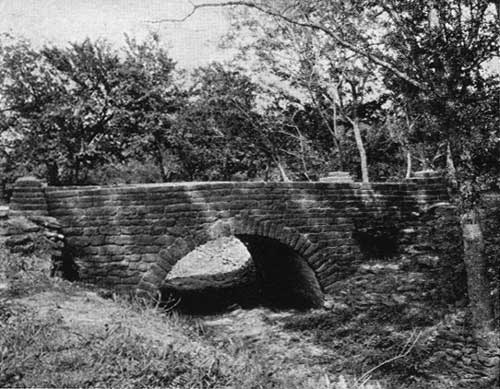
|
|
Canyon Park, Oklahoma City, Oklahoma
|
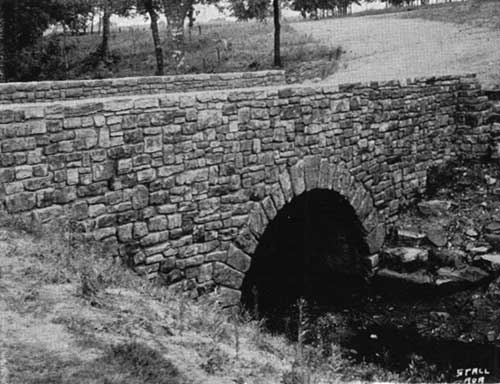
|
|
Wintersmith Metropolitan Park, Ada, Oklahoma
|
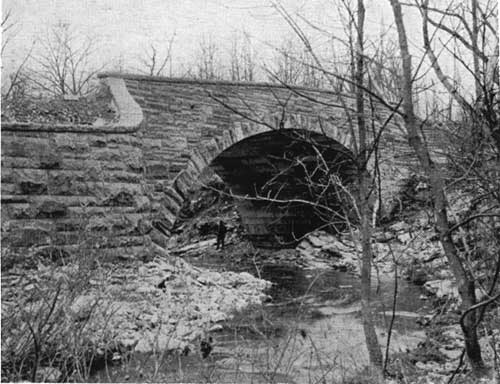
|
|
McCormick's Creek State Park, Indiana
|
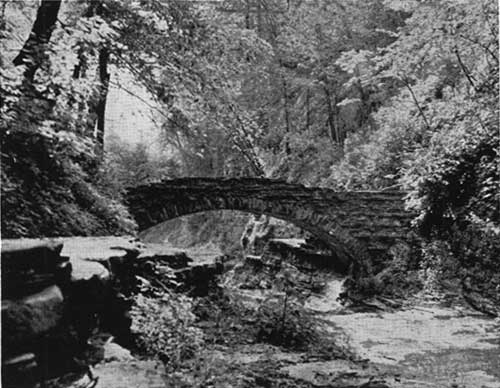
|
|
Buttermilk Falls State Park, New York
|

|
|
New Taughannock Falls State Park, New York
|
Culvert Treatments
The surrounding illustrations picture culvert
treatments in wide variety, from the most casual naturalistic treatments
of the examples above to the more formal facings of the lower row.
Particularly well blended to its site is the example at lower left.
Within the range of the culverts shown on this and the following page
should be found one to suit almost every possible topographical
condition, as well as the inherent limitations of any kind of native
rock.

|
|
Plate E-7 (click on image for a PDF version)
|
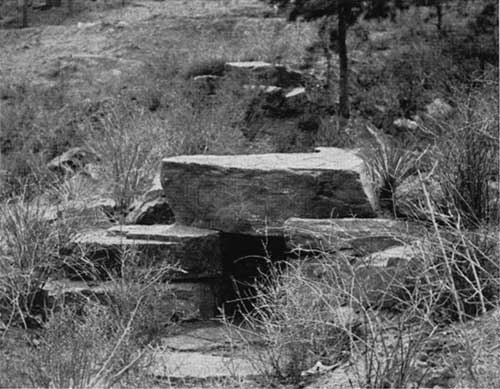
|
|
Loveland Mountain Metropolitan Park, Colorado
|
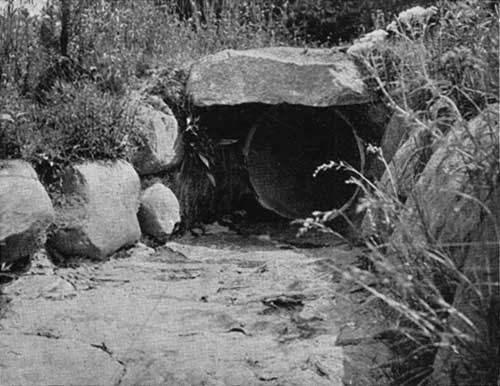
|
|
Bronx River Parkway, New York
|
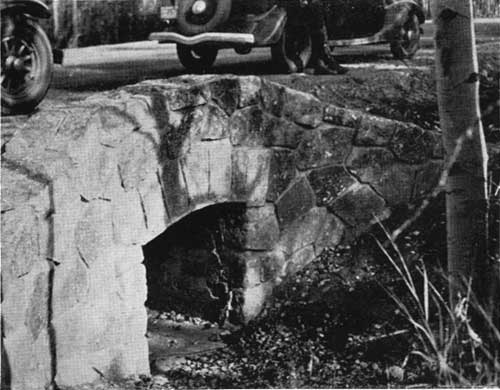
|
|
Rocky Mountain National Park
|
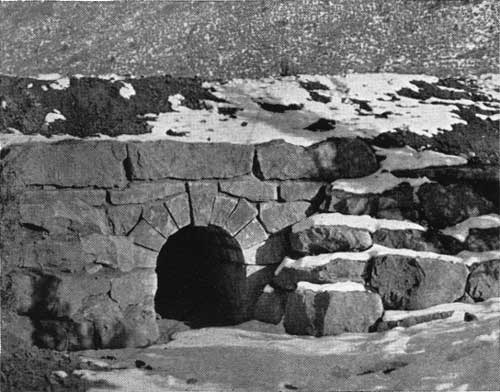
|
|
Hillcrest Park, Durango, Colorado
|
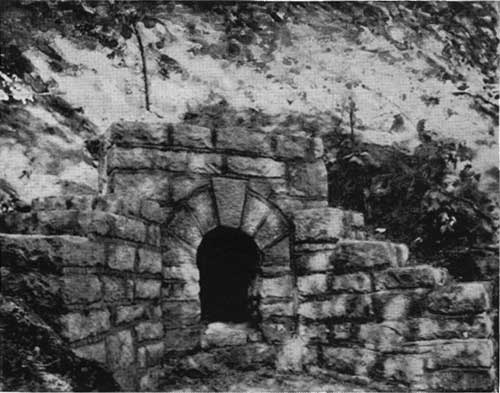
|
|
Pere Marquette State Park, Illinois
|
Stone End Walls of Culverts
Round about are grouped stone-faced end walls of
culverts showing varied stone techniques. Illustrated are several
possibilities for blending and tapering off the end walls to the banks
by stepping down or curving the coping line and by the employment of
wing walls. The climax in this presentation of culverts is the example
at lower right—twin culverts that offer a solution where the
drainage flow is uncommonly heavy.
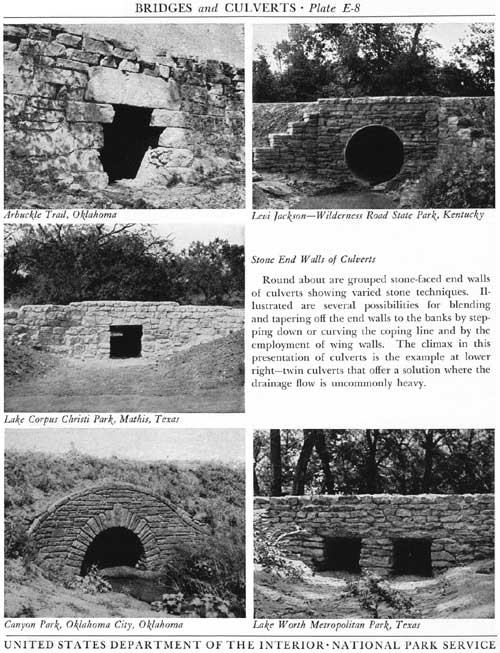
|
|
Plate E-8 (click on image for a PDF version)
|

|
|
Arbuckle Trail, Oklahoma
|
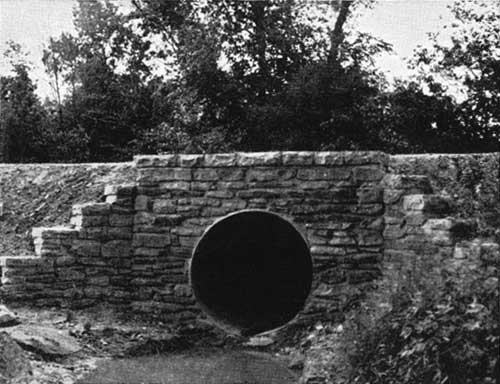
|
|
Levi Jackson—Wilderness Road State Park, Kentucky
|
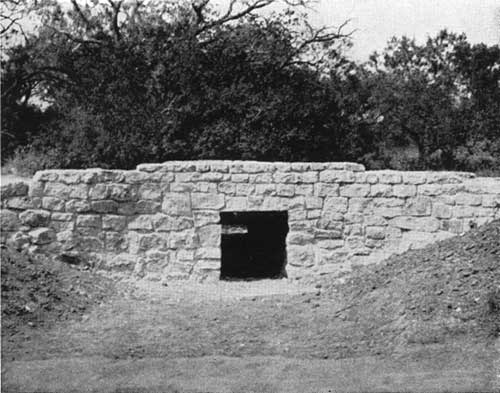
|
|
Lakr Corphus Christi Park, Mathis, Texas
|
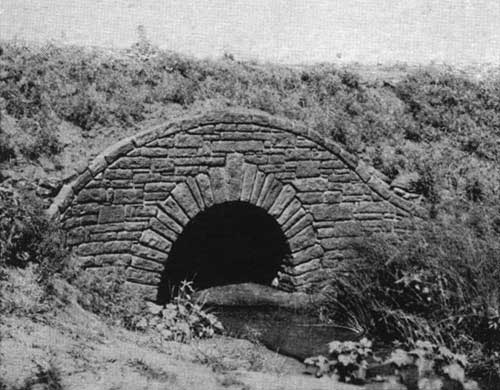
|
|
Canyon Park, Oklahoma City, Oklahoma
|
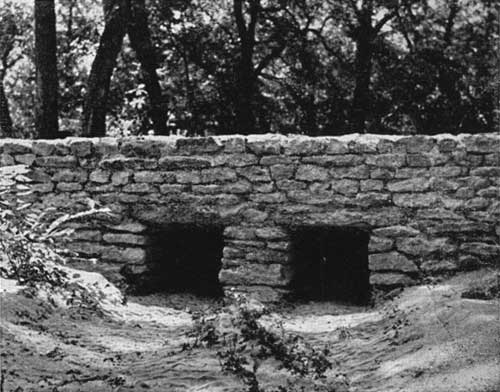
|
|
Lake Worth Metropolitan Park, Texas
|
park_structures_facilities/sece.htm
Last Updated: 5-Dec-2011
|

















































